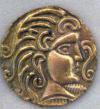Hubble Watches How a Giant Planet Grows

NASA’s Hubble Space Telescope is giving astronomers a rare look at a Jupiter-sized, still-forming planet that is feeding off material surrounding a young star.
“We just don’t know very much about how giant planets grow,” said Brendan Bowler of the University of Texas at Austin. “This planetary system gives us the first opportunity to witness material falling onto a planet. Our results open up a new area for this research.”
Credits: NASA, ESA, STScI, Joseph Olmsted (STScI)
Though over 4,000 exoplanets have been cataloged so far, only about 15 have been directly imaged to date by telescopes. And the planets are so far away and small, they are simply dots in the best photos. The team’s fresh technique for using Hubble to directly image this planet paves a new route for further exoplanet research, especially during a planet’s formative years.
This huge exoplanet, designated PDS 70b, orbits the orange dwarf star PDS 70, which is already known to have two actively forming planets inside a huge disk of dust and gas encircling the star. The system is located 370 light-years from Earth in the constellation Centaurus.
“This system is so exciting because we can witness the formation of a planet,” said Yifan Zhou, also of the University of Texas at Austin. “This is the youngest bona fide planet Hubble has ever directly imaged.” At a youthful five million years, the planet is still gathering material and building up mass.
Hubble’s ultraviolet light (UV) sensitivity offers a unique look at radiation from extremely hot gas falling onto the planet. “Hubble’s observations allowed us to estimate how fast the planet is gaining mass,” added Zhou.
Credits: ESO, VLT, André B. Müller (ESO)
The UV observations, which add to the body of research about this planet, allowed the team to directly measure the planet’s mass growth rate for the first time. The remote world has already bulked up to five times the mass of Jupiter over a period of about five million years. The present measured accretion rate has dwindled to the point where, if the rate remained steady for another million years, the planet would only increase by approximately an additional 1/100th of a Jupiter-mass.
Zhou and Bowler emphasize that these observations are a single snapshot in time – more data are required to determine if the rate at which the planet is adding mass is increasing or decreasing. “Our measurements suggest that the planet is in the tail end of its formation process.”
The youthful PDS 70 system is filled with a primordial gas-and-dust disk that provides fuel to feed the growth of planets throughout the entire system. The planet PDS 70b is encircled by its own gas-and-dust disk that’s siphoning material from the vastly larger circumstellar disk. The researchers hypothesize that magnetic field lines extend from its circumplanetary disk down to the exoplanet’s atmosphere and are funneling material onto the planet’s surface.
“If this material follows columns from the disk onto the planet, it would cause local hot spots,” Zhou explained. “These hot spots could be at least 10 times hotter than the temperature of the planet.” These hot patches were found to glow fiercely in UV light.
Credits: Joseph DePasquale (STScI)
These observations offer insights into how gas giant planets formed around our Sun 4.6 billion years ago. Jupiter may have bulked up on a surrounding disk of infalling material. Its major moons would have also formed from leftovers in that disk.
A challenge to the team was overcoming the glare of the parent star. PDS 70b orbits at approximately the same distance as Uranus does from the Sun, but its star is more than 3,000 times brighter than the planet at UV wavelengths. As Zhou processed the images, he very carefully removed the star’s glare to leave behind only light emitted by the planet. In doing so, he improved the limit of how close a planet can be to its star in Hubble observations by a factor of five.
“Thirty-one years after launch, we’re still finding new ways to use Hubble,” Bowler added. “Yifan’s observing strategy and post-processing technique will open new windows into studying similar systems, or even the same system, repeatedly with Hubble. With future observations, we could potentially discover when the majority of the gas and dust falls onto their planets and if it does so at a constant rate.”
The researchers’ results were published in April 2021 in The Astronomical Journal.
The Hubble Space Telescope is a project of international cooperation between NASA and ESA (European Space Agency). NASA’s Goddard Space Flight Center in Greenbelt, Maryland, manages the telescope. The Space Telescope Science Institute (STScI) in Baltimore, Maryland, conducts Hubble science operations. STScI is operated for NASA by the Association of Universities for Research in Astronomy in Washington, D.C.
Contacts and sources:
Claire Andreoli
NASA’s Goddard Space Flight Center,
Source:
Anyone can join.
Anyone can contribute.
Anyone can become informed about their world.
"United We Stand" Click Here To Create Your Personal Citizen Journalist Account Today, Be Sure To Invite Your Friends.
Before It’s News® is a community of individuals who report on what’s going on around them, from all around the world. Anyone can join. Anyone can contribute. Anyone can become informed about their world. "United We Stand" Click Here To Create Your Personal Citizen Journalist Account Today, Be Sure To Invite Your Friends.
LION'S MANE PRODUCT
Try Our Lion’s Mane WHOLE MIND Nootropic Blend 60 Capsules
Mushrooms are having a moment. One fabulous fungus in particular, lion’s mane, may help improve memory, depression and anxiety symptoms. They are also an excellent source of nutrients that show promise as a therapy for dementia, and other neurodegenerative diseases. If you’re living with anxiety or depression, you may be curious about all the therapy options out there — including the natural ones.Our Lion’s Mane WHOLE MIND Nootropic Blend has been formulated to utilize the potency of Lion’s mane but also include the benefits of four other Highly Beneficial Mushrooms. Synergistically, they work together to Build your health through improving cognitive function and immunity regardless of your age. Our Nootropic not only improves your Cognitive Function and Activates your Immune System, but it benefits growth of Essential Gut Flora, further enhancing your Vitality.
Our Formula includes: Lion’s Mane Mushrooms which Increase Brain Power through nerve growth, lessen anxiety, reduce depression, and improve concentration. Its an excellent adaptogen, promotes sleep and improves immunity. Shiitake Mushrooms which Fight cancer cells and infectious disease, boost the immune system, promotes brain function, and serves as a source of B vitamins. Maitake Mushrooms which regulate blood sugar levels of diabetics, reduce hypertension and boosts the immune system. Reishi Mushrooms which Fight inflammation, liver disease, fatigue, tumor growth and cancer. They Improve skin disorders and soothes digestive problems, stomach ulcers and leaky gut syndrome. Chaga Mushrooms which have anti-aging effects, boost immune function, improve stamina and athletic performance, even act as a natural aphrodisiac, fighting diabetes and improving liver function. Try Our Lion’s Mane WHOLE MIND Nootropic Blend 60 Capsules Today. Be 100% Satisfied or Receive a Full Money Back Guarantee. Order Yours Today by Following This Link.








BWAHAHAHA yeah right bwahahaha